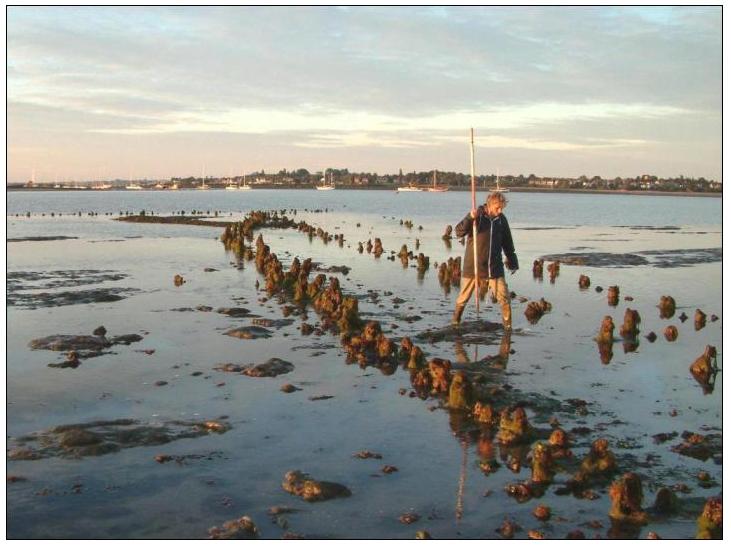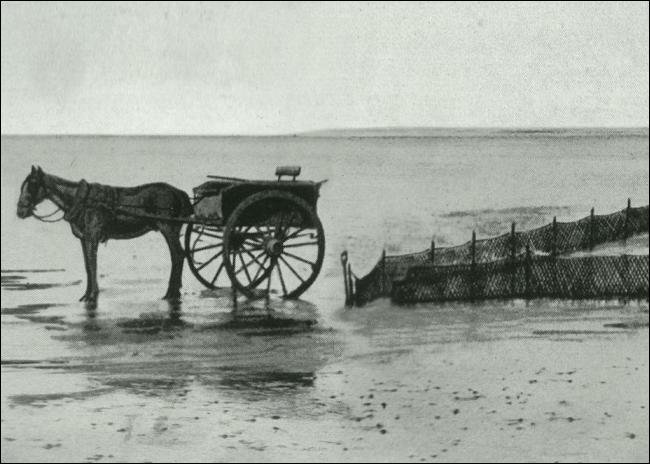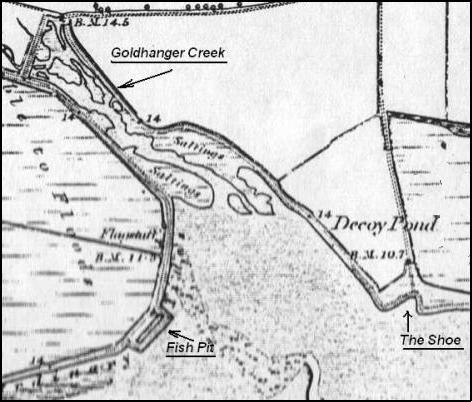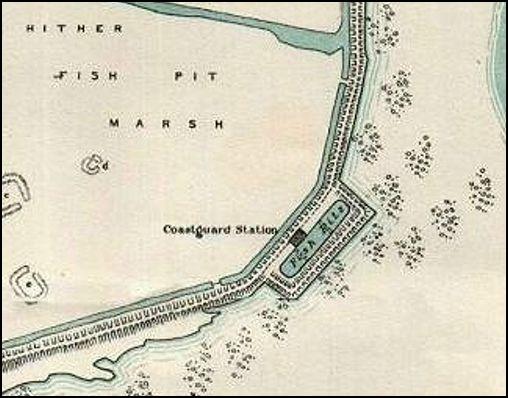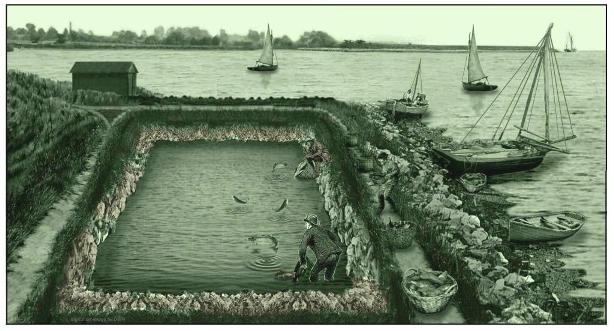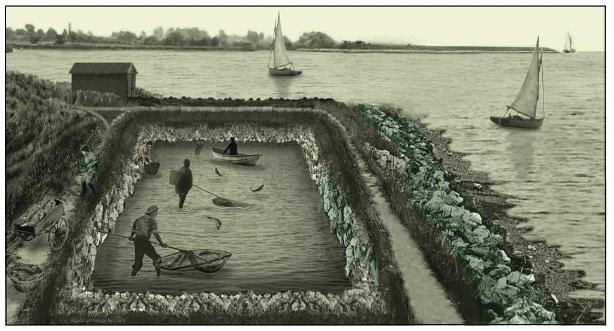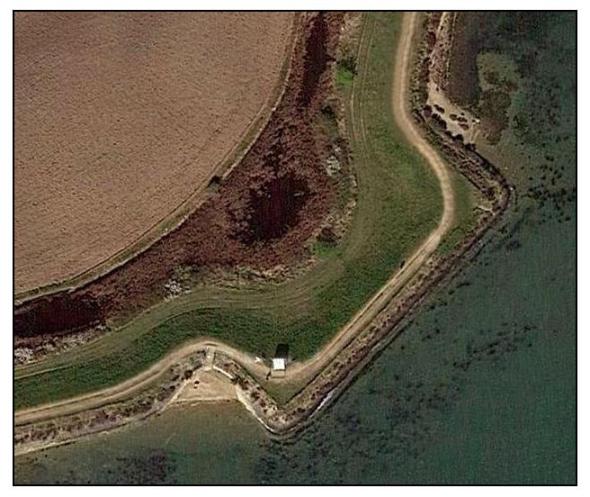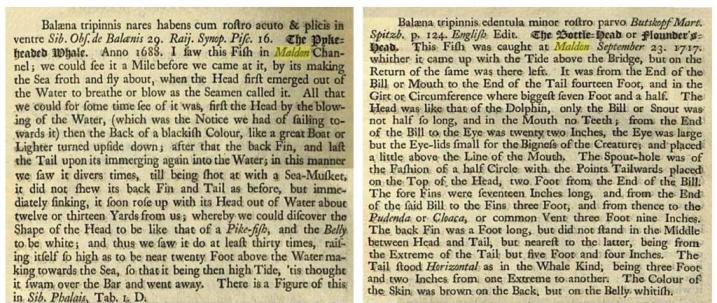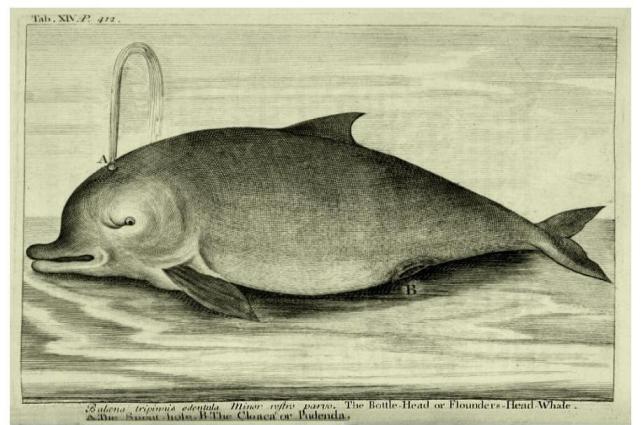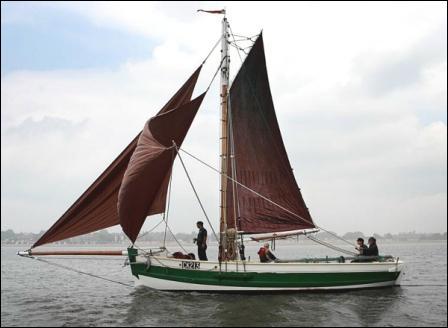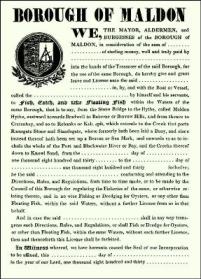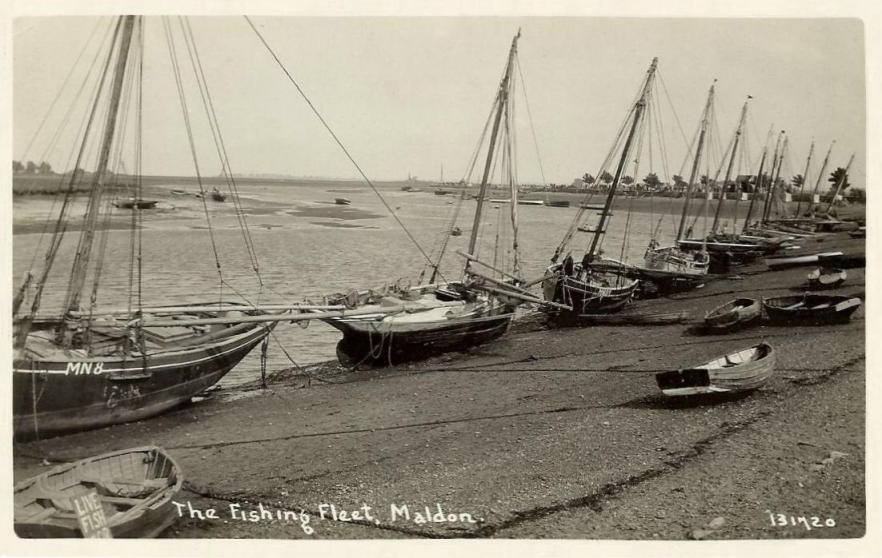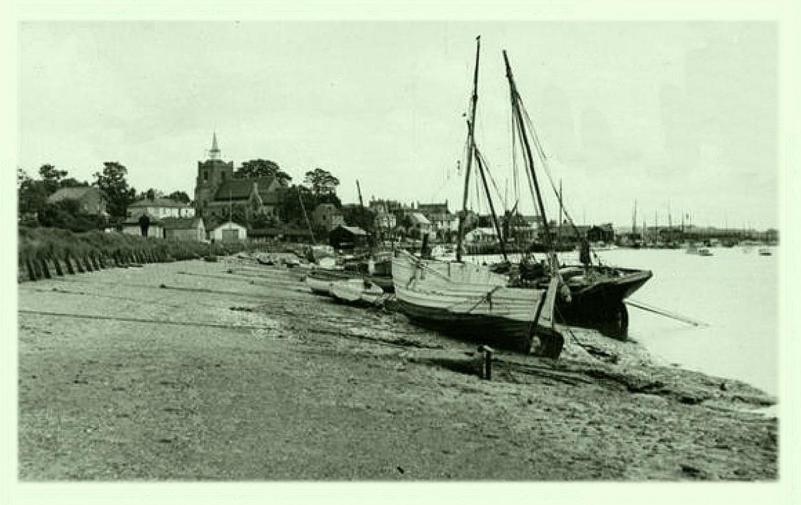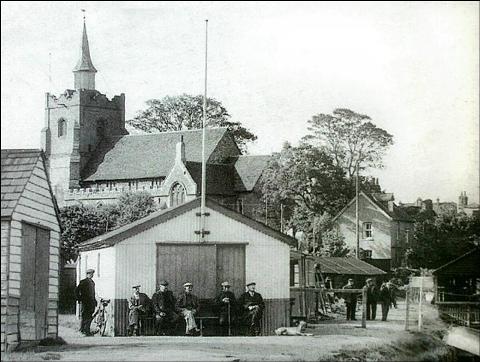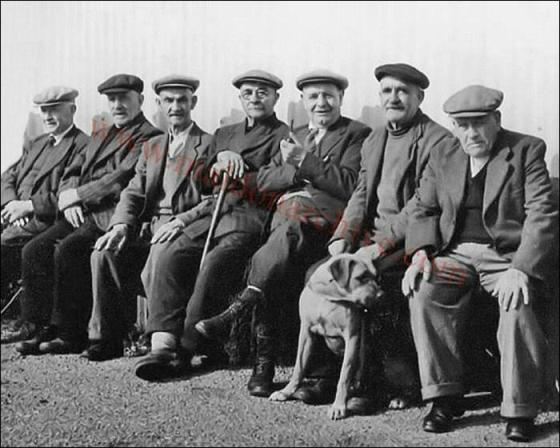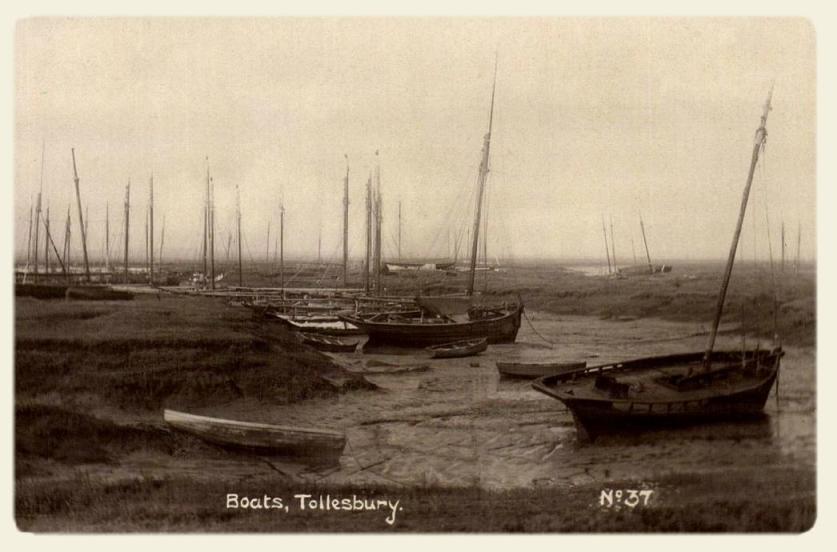Commercial
Fishing at Goldhanger and in the Blackwater
Contents
(with links)
|
o
Records of fishing and
exceptional fish caught in the Blackwater Pre-1800 1800-1900 1900-2000 post 2000 post 2010 o
Fishing in the Blackwater
recently o
Summary |
|
Commercial
fishing legacies
Fishing has been a major
commercial activity in the Blackwater Estuary for centuries and Goldhanger
fishermen were part of it. Very little documentary evidence has been found that
related to Goldhanger, however several pieces of tangible evidence and legacies
remains...
St. Peter is the Patron Saint of fisherman – Goldhanger Church
goes back to 1100s. It’s not known when
the name was adopted, but it could well have been given the name by the monks
of Beeleigh Abbey who owned much of the land from Heybridge to Goldhanger and
probably fished from the marshes up until the time of the Reformation.
Fish Street clearly derives its name from an association with
fishing in the estuary. Before the seawall was built around the estuary and the
creek, at high tide the water would have been right up to lower end of Fish St.
This street also had the reputation of providing hospitality to Maldon
fishermen who would frequent the several unlicensed alehouses and a house of ill repute
when they temporarily moored in the Creek when the wind and tide was against
them and they waited for the wind or tide to change. In more recent years some
would cycle back to Maldon and return later.
Wooden posts still protruding out of the mud in The Creek are
believed to be the remains of a substantial jetty that would have been used by
fishing smacks in the 18th &19th centuries...
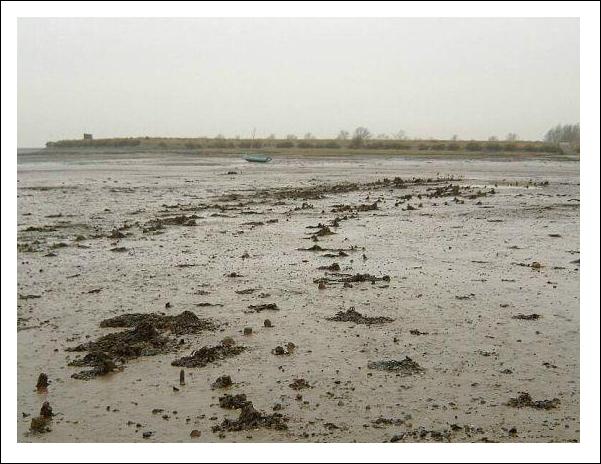
a recent photo and
an artist’s impression of the jetty
there is more about these
posts and the jetty at... Ancient wooden posts in the Creek
local historian Crawshay Frost believed the jetty was of Roman origin
Fish Traps
From SEAX - Unlocking Essex's Past
Monument: Blackwater Estuary Site 28, The Stumble,
Goldhanger, SMR No. 13661, Investigated between 1987-95
Iron Age wooden
fish-traps - a group of vertical and oblique posts to which nets could be
attached.
Dated 700BC to
42AD
Maldon amateur archaeologist
Ron Hall reported on his investigations on fish traps in the Blackwater for the
Mersea Island Museum website. Here as a short extract from
his report...
Fish
traps or 'weirs' as they are termed locally, are to be found in many locations
within the Blackwater estuary... The V shaped construction was oriented with
the open end facing the ebb (or outgoing) tide, and at the base of the V some
form of collecting area, consisting of a basket or pound, was constructed. The
lengths of the arms of the V differ at each trap location. One West Mersea trap
is about 170 metres long whilst the complex of traps further up the river at
Collins Creek extends for some 1,660 metres... Timber from a number of the
Blackwater fish trap sites have been radiocarbon dated. Results reveal an age
of between 1300 to 1100 years old, indicating that the traps date from the
Saxon times of 600 to 800 AD...
Here is one of Ron’s fish
trap photos, with courtesy of his executor:
the remains of
a fish trap off Bradwell, with West Mersea in the background
more of Ron’s
fish trap photos can be seen at... archaeologydataservice.ac.uk/archives
From The Oxford Handbook of Wetland Archaeology by Menotti & O'Sullivan in 2012...
On
the Blackwater estuary, Essex, fish weirs have been typically dated to the
Anglo-Saxon period, between AD 650-800; although there was fishing activity up
until the 10th century. The Anglo-Saxon weirs are usually large, with fences up
to 100m-300m in length, and L-shaped or V-shaped structures built of oak,
alder, birch, and willow posts, with well-surving baskets of hazel buried in
the clays at the trap ends.
At
the Sales
Point fish weir at the mouth of the Blackwater estuary, located
close to a small Saxon church [St Peters on the Wall], a
large, thick deposit of fish bone was discovered beside the trap end indicating
that cod and
bass
fish were being gutted and filleted on the mudflats and the fishbone dumped
beside the weirs.
From Essex County Council’s Field Archaeology Unit...
The
Essex tidal estuaries are the site of a number of timber-built fish traps,
their distribution being particularly dense in the Blackwater estuary where six
sites have been identified through the work of local archaeologists and aerial
reconnaissance. The Blackwater examples are Saxon in date and comprise large
and complex monuments, comprising numerous wooden posts in various alignments,
along with wattle-work (sails and rods) and basketry. Studies have included...
detailed survey of a complex of traps at Collins Creek (near
Lauriston Farm).
From Once Upon a Tide - Hervey Benham, wrote in 1955...
The
more ancient forms of fishery, the weirs and the kettles, which had furnished
the monastic Friday fare, were
still in use up to the end of the nineteenth century. They were similar in form
and purpose, but were of a different construction.
Kettles were netting enclosures, built
between high and low water-marks, in which fish were trapped as the tide ebbed.
The catch was mostly plaice, dabs, soles, and flounders, taken in summer. In
winter the netting was removed from the posts and repaired before being
replaced in spring.
Weirs were more substantial and
permanent, being were built of oak posts six to eight feet high, set several
feet apart and thatched with wattling. They were of a triangular shape, on
sloping ground, with the upper, land-ward, side open. In the apex was a lidded
box into which the fish were scooped. Because the broken stumps of old posts
were a menace to shipping, weirs were prohibited in 1861.
Fish Pits were located adjacent to what is now the Goldhanger
Sailing Club near Bounds Farm. This was once the
location of the Goldhanger Saltworks. They appear on the
1820 Tithe map and are listed in the
Tithe Awards as part of Bounds Farm property, they are also shown on 1900 OS map and a map in the Proceedings Antiquaries Society of 1910.
They would have been used to temporarily hold large catches of fish, oysters,
shellfish and eels caught in the estuary and further out to sea in the days
when ice was expensive and refrigerators were not available. We don’t know when
they were first built.
maps of the fish
pits at Bounds Farm
No early photos or postcards showing the Goldhanger
Fish Pits have ever been seen, however these artist’s impressions give glues to
what they may have been like when being worked...
|
Transferring
the catch from the fishing
boats to the pit... |
|
||||
|
|
|
|
|||
|
Retrieving
the fish from the pit maybe
weeks or even months later |
|
||||
|
|
|||||
recent
satellite view of the Fish Pits remnants
|
|||||
In Once Upon a Tide - Hervey Benham,
wrote...
An
ancient method of fish-storage was the fish pit. Flat-fish and round fish alike
were put into these pits, where they survived without food or attention until
the time came to catch for selling. Flounders succeeded in burying themselves
deep in the mud on the floor of the pits and lived there for years. When demand
was keen the pits would be drained and the wily flounders excavated. Fish pits
were still in use at Maldon
until 1833. By this time markets had been opened by Well Smacks and the use of
ice.
Saltworks were adjacent to the
Fish Pits on the site of Goldhanger Sailing Club. Before the availability of
low-cost ice and refrigeration, salt was an essential commodity to be able to
transport fresh fish inland to market. There is much more about the Goldhanger
saltworks at... Salt Extraction on the North Bank of the
Blackwater
Oyster fishing and cultivation has been an activity in the
Blackwater Estuary for centuries. Oyster shells litter the foreshore and oyster
shell are frequently found in the gardens in the village. Over the last 20
years commercial oyster beds have been established at a location frequently
referred to as Goldhanger
Creek, but is actually located in the estuary closer to
Lauristons Farm The business is known as The
Maldon Oyster Company and was started by the late Clarrie Devall. The
Company’s oysters are sold around the world. There is more about the local
oysters at... Goldhanger Oyster Beds
Local
Documentary Evidence - in approximate chronological order
An
extract from a 1886 sale catalogue (ERO D/F 63/1/10/6)
Bounds Farm, Goldhanger
Comprising
farmhouse, farm buildings, double tenement cottage with garden and bakehouse
and about 205
acres of arable and pasture land. With plan.
Includes
manuscript note that the Coast Guard flag staff stands upon Lot 2 (Bounds Farm)
and the
Government pays 10s. per annum rent.
There is a
shelter hut of the Coast Guard for which they pay 6d per annum,
The Fishermen agree to
pay 5s. per annum for the use of the Pits and Drying ground on the foreshore
Census Returns available for Goldhanger...
These figures do
not support signs of an “extensive fishing trade”...
The 1841 Census
shows Fishermen: 4, Agricultural Labourers:
60
The 1851 Census
shows Fishermen: 4, Agricultural Labourers:
39
The 1901 Census
shows Fisherman: 1, Agricultural Labourers and Horseman: 57
The Comprehensive Gazetteer of England and Wales of 1894...
Goldhanger, a village and a parish in Essex. The village stands on the N
side of the Blackwater's estuary, 4 miles from Maldon. An extensive fishing
trade is carried on here.
Kelley’s Directories of 1892 and
1899 for Goldhanger both record... “A fishing trade is carried on here”.
Extract
from The Society of Antiquaries Proceedings in 1910. . .
Report of the Red-Hills
Exploration Committee
It was part of our
original intention to explore the tank-like depressions on Hither Fish-pit Marsh,
but during operations we learned that fish-pits had formerly been in common use in the district,
and that three such pits
had been constructed in comparatively recent times close to the Coastguard
station on the sea-wall. Another pit on the east side of the creek had been in
use within the memory of some of the inhabitants.
In former times fishing was an important industry at Goldhanger.
When a large catch was made the fish were kept in these pits
until required. It is said that corks at the end of
strings were tied to the tails of the fish and the corks floating on the
surface made it easy to procure the fish when wanted. The fish having now
almost left this district the pits have fallen into disuse, and those at the
coastguard station are in a dirty and stagnant condition, while the one on the
edge of the creek has been broken through, and is now used as a dock for
repairing the boats. Owing to the resemblance of the tanks on the marsh to
these fish-pits we concluded that they must have been intended for a similar
purpose, and decided not to explore them as the season was advanced and our
funds exhausted,
As further evidence
of the once important fishing industry, not only does the marsh bear this name,
hut the roadway from the village is called Fish Street, and the old track way
across the marsh is said to have been made for the carts to bring the fish from
the boats.
Another point of
interest at Goldhanger was a large pile foundation in the head of the creek,
which was exposed at low tide. Upwards of sixty large piles are arranged in
rectangular form. [now assumed to be a jetty,
see... Ancient wooden posts in the Creek].
In Goldhanger - an
Estuary Village the Maura Benham wrote in
1977:
The creek itself must have been a useful waterway, and up to the early
years of the last century fishing smacks unloaded their catch at the quay at
the bottom of the road called Fish Street which leads up to the Square.
Hervey Benham describes the two ancient forms of fishery, the weirs and
the kettles, or 'kiddies'. in Once Upon a Tide (1955). Kettles were netting
enclosures, built between high and low watermarks, in which fish were trapped
as the tide ebbed. Weirs were more substantial and permanent. They were
generally of triangular shape, built on sloping ground, with the upper,
landward, side open, and in the apex was a lidded box into which the fish were
scooped with a lave net (or 'Digel’) from the pool left at low water.
The will dated 1575 of George Osborne of Goldhanger bequeathed “To my
dear mother my half-boat, also a bream net and a new vag-net; to my
brother-in-law Heard my all things else pertaining to sea-craft for the 6s
which I owe him”. The meanings of the words used to describe the nets are
obscure to me, but David Heard, who now sells his catch from his house in Fish
Street, has suggested that the nets were probably a beam net and drag net. The
latter might have been a fyke net which is held open by wooden hoops, but it is
unlikely this type was in common use here at that time.
In 1882 there was an extensive fishing trade.
The Goldhanger Historic Settlement Assessment produced by Essex County Council in 2007
included the sentence...
“In 1847 a marine store dealer is listed and by 1882 an extensive
fishing trade is reported for the Parish”.
Records of fishing and exceptional fish caught
in the Blackwater
To understand
more about past fishing on the Blackwater we need to look beyond records
relating only to Goldhanger and to look at information associated with the
estuary generally and to other fishing locations, such as Maldon, Tollesbury
and Mersea. The following extracts from many sources, provide much evidence of
how abundant and diverse fish stocks once were in the estuary, and together
with records of the related fishing activities and boats, give an insight to
the scale of past commercial fishing and “Game fishing” in the Blackwater
Estuary.
It is notable
that several publications on game fishing from the Victorian era referred to
the benefit of fishing in the Blackwater Estuary. It being one of the largest
salt water estuaries in the UK that had the advantage of being on the east
coast, protected from prevailing westerly winds and gales. This makes it one of
the safest and most pleasant places for sea fishing in the UK without the need
to venture out into unpredictable rough oceans.
The extracts
below are listed in approximate chronological order...
40BC-400AD The Roman period
Fish and fishing
played as important a part in the Roman economy. Fresh or preserved, fish was
served at practically every table. The Romans were known to use fish tanks in
their sea going vessels. Fish traps and weirs were used in
estuaries. The Blackwater estuary was the source of fish and oysters for
Camulodunum (Colchester) and Maldon during the Roman occupation and the Romans exploited
the sea salt resource on Osea Island and at Maldon, most probably used to
preserve their fish.
Local historian Crawshay Frost believed the jetty in Goldhanger Creek was of Roman origin.
700-1000 The Viking
period
The Vikings were
very able fishermen. There is archaeological evidence to show that fish formed
a major part of the Viking’s diet. They caught herring and cod in the Baltic
Sea, the North Sea and the North Atlantic. Their fishing skills and their fish
would have been brought into the Blackwater Estuary at the time of the Battle
of Maldon in 991. Ninety Viking longships sailed up the estuary carrying 4000
Viking warriors. Few if any went home.
1155 The position of River Bailiff on the Blackwater was created at this time
as part of a charter granted to Maldon by Henry II. The role has always been to
protect the town's fishing rights in the Blackwater, for which purpose he was
authorised to apprehend any person fishing without a license from Maldon
Council. The position still exists today.
1180-1500s Impressions & Comments by Havelock
Ellis (published in 1920)
Beeleigh
Abbey - Along
peaceful walks by lovely streams in this most delightful corner of Essex are
the charming remains of the Abbey of Beeleigh. The White Canons ruled Maldon,
but they lived at Beeleigh. They appear to have been admirable priests and
their Abbots seem to have been exceptionally wise and prudent. This sweet
pastoral scenery, these slow streams with luxuriant banks and pleasant,
sheltered walks, were altogether to their taste. Here were their fish-ponds and their mills. Here were all
the luxuries of Epicurean austerity.
Most monasteries
maintained a series of “monastic fish ponds” to supply the monks with fish on
Fridays to support this ancient Catholic tradition. According to legend, John Dory is the fish that St. Peter caught
when Christ told him: "go thou to the sea, and cast in a hook...". To
commemorate this the Spanish call the fish San
Pedro and the French call it Saint-Pierre
(St Peter), in English it is known as John Dory (possibly from the French, jaune dorée – yellow gilded), and is
said to be the fish favoured by the monks.
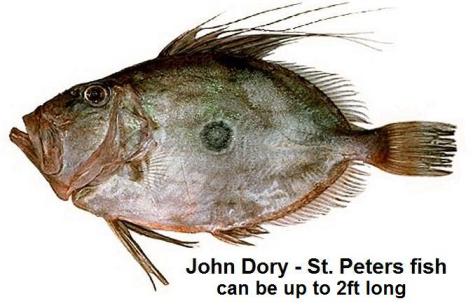
Up until the Reformation Beeleigh Abbey owned all the marshes
from Heybridge to Goldhanger and may well have caught their fish in this area
on the north bank of the Blackwater using fish traps or kettles, and then
transported them to their ponds at Beeleigh.
1299 Essex
Naturalist - in the 1906 publication...
Whale at Mersea in1299 - Mr. Miller Christy sends the following extract
from The Wardrobe Accounts of King Edward
I. in the Society of Antiquaries of 1787 (we are indebted to Mr. W.C. Waller,
for a translation of the Latin):
Charges in respect of a whale per
the Sheriff of Essex - To John de la Lee, Sheriff of Essex and Herts, for
moneys paid by him to divers persons in charge of a certain whale caught off
the island of Mersea; for one empty case bought to put the whale
in; for salt bought to salt the same; for the carriage of the same
from the island aforesaid to Staunford; together with the expenses of one man
with a team conducting the said whale there in the month of May: £0 14s 8d
1547 a short extract
from an article in the Maldon & Burnham Standard in 2018 written by Stephen
Nunn...
"From as early as 1547, Maldon had a fish market with two or three stalls
located in Silver Street. This arrangement continued well into the 1720s and
the street name could be an allusion to silver fish scales. Street hawking was
also prevalent in the 18th century when their arrival would be announced by the
town crier".
1565 – 1577 this extract from Notes on Shipping and
Sea-borne Trade of Essex in the Essex
Archaeological Society proceedings of 1926 indicated where the lading
places were in the blackwater and the number of ships at Maldon...
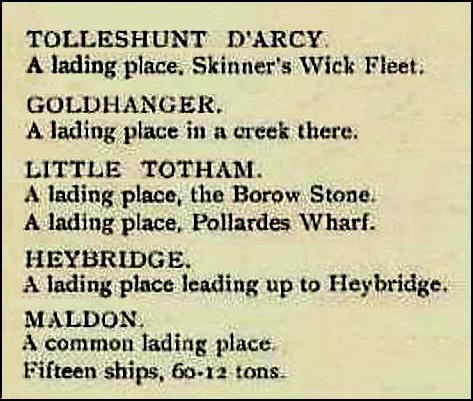
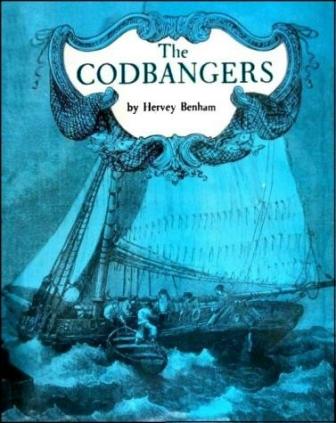 1580s – 1840s The
Codbangers written by
Hervey Benham in 1979
1580s – 1840s The
Codbangers written by
Hervey Benham in 1979
Although primary
about Icelandic cod fishing in the middle ages, the book also refers fishing on
Dogger Bank in the North Sea, and has references to Maldon, so the book
contributes to our knowledge of activities on the Blackwater over this period.
For example:
- 1581 two boats
of twenty-five tons registered at Maldon
- Fourteen-day
voyages to the Dogger Bank for cod
- The Codbangers
task was to stun or kill the cod by knocking them on the head
- Freshly killed
cod was rushed to London labelled 'Live Cod'
Some extracts from the book are on a
separate webpage on this site at... Hervey Benham extracts
1683-1775 The Proceedings
of the Royal Society of London, Philosophical Transactions...
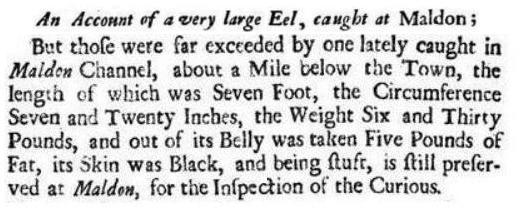
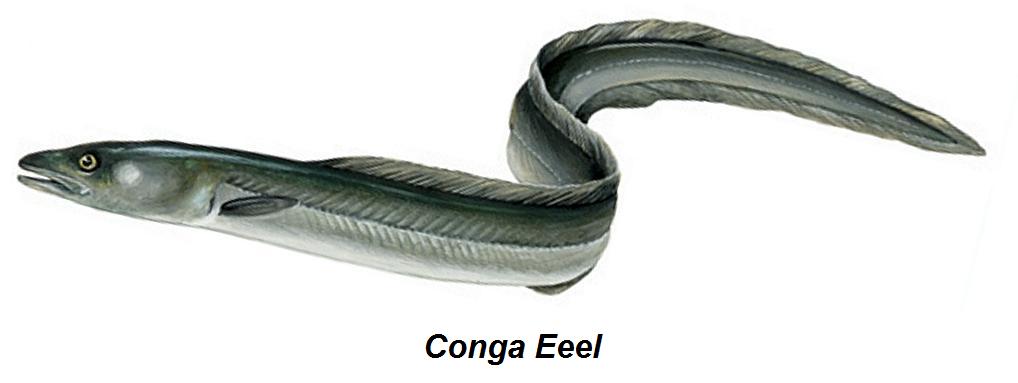
1688 & 1717
The History and Antiquities of Harwich
and Dovercourt published in 1730 recorded and
described Bottle Head or Flounders-Head Whales seen in 1688 and 1717 in the
Blackwater with these words and a lithographic drawing...
select to enlarge
Today the specie is better known
as the Northern Bottlenose Whale.
1722 Tour Through the Eastern Counties of England by Daniel Defoe, in which he wrote...
...there is nothing for many miles but a continued level of unhealthy
marshes till we come to the mouth of the River Chelmer, and Blackwater. These
rivers united make a large firth, or inlet of the sea, which our fishermen and
seamen, who use it as a port, called Maldon Water.
In this inlet of the sea is Osey, or Osyth Island, commonly called Oosy Island,
so well known by our London men of pleasure for the infinite number of wild
fowl...
...It is on this shore, and near this creek, that the greatest quantity
of fresh fish is caught which supplies not this country only, but the London
markets also. The shore is full of shoals and sands, with some deep channels
between; all which are so full of fish
that not only the Barking
fishing-smacks come hither to fish, but the whole shore is full of
small fisher-boats in very great numbers, belonging to the villages
and towns on the coast. They come in every tide with what they take;
and selling the smaller fish in the country, send the best and largest away
upon horses, which go night and day to London market...
...The chief sort of fish which they carry to London are soles, which they take, sometimes exceeding
large, and yield a very good price at London market, also sometimes middling turbot, with whiting,
codling and large flounders.
The small fish they sell in the country.
1776 The Blackwater estuary froze over in a
hard winter to a depth of 2ft deep from Osea Island to Maldon locking in all
the fishing boats and locking out all other commercial vessels. This resulted
in no fish or coal reaching the town and many deaths from starvation and
hypothermia.
1800s Heybridge
in the Nineteenth and Twentieth Centuries,
Beryl Claydon wrote in 2012...
“The tide mill, located in the section of the river known as Mill Reach, is recorded in documents as far
back as 1819. As the tide rose, water was allowed to flow into three enclosed ponds.
When the tide began to drop, sluices would divert the flow past the mill
building and drove a large water wheel... As the gates were raised, a frame of
enclosed mesh that captured eels and flounders
was placed in front of the sluice gate”.
1808 Once
Upon a Tide - Hervey
Benham, wrote in 1955...
Probably the oldest craft in full commission in the country, and perhaps
in North Europe, the oyster smack Boadicea
was built at Maldon in 1808. In
essentials she remains a unique survival of the eighteenth-century.
Clinker-built by James Williamson of Maldon,
the Boadicea spent her youth at Burnham and Bradwell, and in 1825 came to
Tollesbury. [where she remains]...
Boadicea in the Blackwater today Maldon fishing license
1836 The
Borough of Maldon issued a standard license to “fish, catch and take Floating
fish” (above, select to enlarge)
1844 Once
Upon a Tide - Hervey
Benham, wrote in 1955...
Throughout their history the chief occupation of the Essex cutters was
oyster dredging. In 1844 the Colne Fishery Company alone employed five hundred
smacks and two thousand men, and there were probably as many in the Blackwater
at Tollesbury, Mersea and Maldon. In those bountiful days they were a
considerable export, chiefly from Maldon,
where there were sometimes three ships loading simultaneously for Holland and
the Low Countries.
1850-1900 Paintings and drawings
In the Victorian era when there was an
abundance of fish and fishing smacks were available to bring in large catches,
photography wasn’t sufficiently developed to capture the scenes and atmosphere
at sea, particularly at night. However many paintings and lithographic drawings
were produced in that period that captured the dramatic and hazardous
situations that arose in a way that probably could not even be conveyed with
modern photography.
Lithographic drawings were published in
newspapers and magazines associated with articles about the dangers of deep sea
fishing (particularly involving teenage boys) and concerns about over fishing.
A small selection of this artwork is available here...
Lithographic
art from the past
In contrast, many established and now
well known artists were producing impressive oil paintings of dramatic and
evocative scenes of fishing boats at sea, which would have only been produced
for their appealed to wealthy clients. A small selection is also available
here...
Two reasons have been identified that
explain why night-time commercial fishing was regularly undertaken: Many fish
spend daylight hours in deep water. As they are less vulnerable during darkness
they swim and feed near the surface at night. Cod in particular stay in deep
water in daylight and only come up at night. The second reason is that
fishermen based well up the estuary would have no choice but to leave and
return with the tide and favourable winds, which would mean on many occasions
they would be out at sea during the night.
1877 a Board
of Trade enquiry at Colchester reveals Maldon and Goldhanger’s rights to
“floating fish” in the Blackwater...
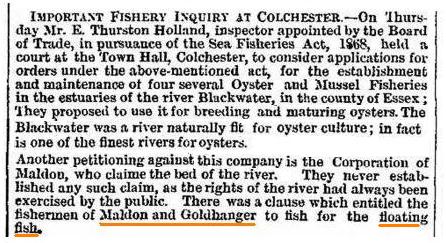
1880 Essex Naturalist, notes: Large Basse in the Blackwater, by Edward A. Fitch...
This hot summer has proved an unusually good season for grey mullet in this river, and a few large
ones have been taken, also several large Basse.
Joe Handley has taken three of this latter fish this summer, weighing
respectively 16 1/2, 16, and 12 1/2bs.; these were all taken, like the mullet,
by shooting the creeks with a peter net.
Years ago mullet were much commoner in this river than now; their
disappearance is to be accounted for, firstly, by the disappearance of the
Zostera marina weed. Another probable cause of the mullet's disappearance is
the prevalence of eel trawlers,
who go into every nook and corner they can, and so are constantly disturbing
this shy fish.
1881 The London
Chronicle...

1884 The
Angler's Diary and Tourist Fisherman's Gazetteer of the Rivers and Lakes of The
World...
Maldon , Essex, on Blackwater: Pike, perch, roach, dace, and a few
trout.
Langford, outside the entrance of the Blackwater river: whiting, cod,
ling, and dabs caught with hook and line.
1886-1898 Report
on the sea fisheries and fishing industries (in 1903) by the Kent and Essex Sea
Fisheries Committee...
Sturgeon - The Blackwater seems
a favourite haunt. A specimen secured near Beeleigh Mills, Maldon
weighed 131lb. Another, conjectured to be 11cwt. was captured alive at the
Point between Heybridge Basin and Maldon, 9th May, 1886; it was
exhibited in the Basin lock with a rope round its tail and hauled up to be
viewed at 1d a head. Still another, a female scaling 212lb. and 7 feet long,
was hauled out of the "Smack Hole", directly opposite Mr Fitch, our
Chairman's residence, close to Maldon, 15th May, 1890. A. Sexton caught one
very near the same spot, 6th June, 1898, and was seen alive by Mr Fitch, length
7 ft. 6in, weight 192lb.

Sturgeon
- can be up to 12 ft long
1890
The Essex Naturalist...
Sharks in the Blackwater.—On the evening of July 12th, Joseph Handley caught two large Topes off
Goldhanger Spit, at the mouth of Goldhanger Creek. These were both caught in
his trawl at successive hauls and were a considerable trouble to get out of the
net and Handley had quite a job to kill them—they proved to be too tenacious of
life to please him.
The species was undoubtedly Galens vulgaris, Flem. Several large
specimens have been taken on the main but fortunately the shark is rare in our
river, although I think that small specimens have occasionally been taken. One
of the sharks caught was from five feet to five feet six inches long, and was
estimated to weigh forty pounds; the other was four feet long, and probably
weighed about thirty pounds.

A Tope is a slender shark that can grow up to 6ft It has several other
names:
school shark, houndshark, snapper shark, and soupfin shark.
1893 Chelmsford Chronicle...
On Monday Edward Hayward, while fishing for eels and flounders in the
Blackwater, between Fullbridge and the Railway Viaduct, captured a fine salmon, weighing 15Ibs.
1894
Maldon and the River Blackwater, by
Edward Arthur Fitch between 1894 & 1899 (several versions)
(Essex Library
ref: E.MAL910)...
E.A. Fitch (1854-1912), was
elected Mayor of Maldon six times in the late 1800s. He was a farmer,
ornithologist, historian, antiquarian, author and was president of the Essex
Field Club. Over several pages of the book he refers to about 24 species of fish that he had either
caught or knew that others had caught or seen them in the estuary.
Specific extracts from the book referring
to fishing are on a separate page on this site at... E.A.
Fitch extracts
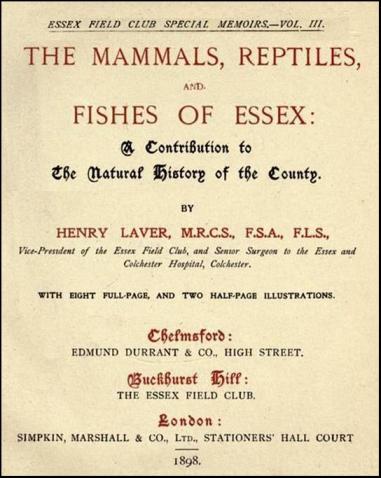 1898 Essex Field Club: Mammals,
Reptiles, and Fishes of Essex by Dr. Henry Laver...
1898 Essex Field Club: Mammals,
Reptiles, and Fishes of Essex by Dr. Henry Laver...
This 170-page book gives an
amazing insight into the demographics of fish in the Blackwater Estuary in the
1800s. It tells us that of the 234
fish species then know in the UK, 113 had been observed in Essex estuaries and 30 of those had been observed in the
Blackwater, or were very common in all Essex estuaries. The 10 species commercially caught in the
Blackwater are also identified. Dr. Laver was a contemporary of Miller Chisty and E.A.Fitch and he
refers to both of them.
Specific extracts from the
book are on a separate page on this site at... Henry Laver extracts
The complete book can be
seen at... archive.org/mammalsreptilesf00laverich
Dr Laver even reports seeing
an Orca Gladiator - killer whale in the
Blackwater...
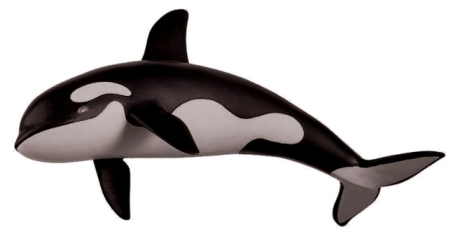
Orca - can be up to 20 ft long
1903 The Victoria history of the county of Essex, by H. Arthur Doubleday & William Page...
Mr. E. A. Fitch records the capture of two very large sturgeons in the Blackwater on May 9, 1886,
and May 15, 1890. The latter, weighed 212 Ib. and measured 7 feet 11 inches in
length.
1903 Report
on the sea fisheries and fishing industries on the Thames Estuary...
Cuttle-Fish
Tribe (Uephalopods) - Little attention has hitherto been paid to the
Cephalopods of our district, hence their distribution and frequency of
visitation are but imperfectly known. Some, however, appear rarely. We know of
two instances of the large, arrow-shaped Flying Squid (Ommastrephes
sagittatus); one captured near Folkestone, the other, a great-sized specimen,
was found by Mr. Fitch stranded on the causeway leading to Northey Island in
the Blackwater, at the end of November 1901.
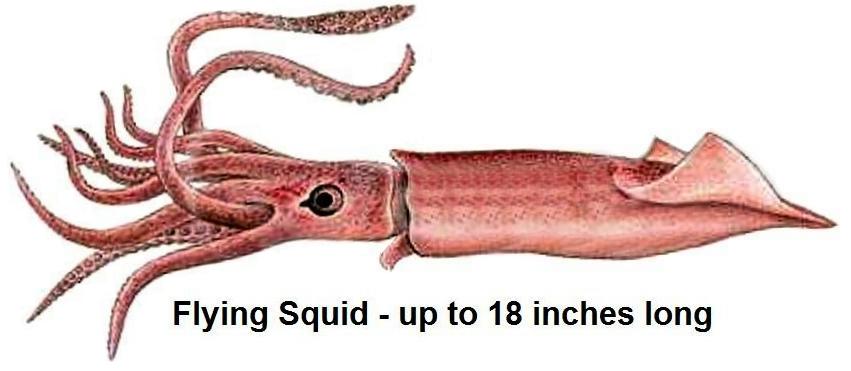
1904 Fishing, by Horace Gordon Hutchinson...
There is a kind
of calm water fishing in boats
in the latter part of the year, when whiting and
codling find their way into many rivers, notably on our east coast.
The Essex Blackwater and Crouch, even for that matter the Thames at Leigh, the
river at Aldeburgh, and several others, are the yearly playground of many
anglers who like to catch sea-fish in still water.
The great
difficulty is to hit off the tide. I remember once not hitting off the tide at
Maldon, on the Blackwater. I remember spending just twenty-four hours away from
home, and fishing for about forty minutes, during the forty minutes we caught
only two or three midgets of fish, bullheads for the most part, and nothing
worth taking away. I have in other days enjoyed very brisk sport with these
Essex whiting and codling on bright winter mornings.
1904 The Times...
Salmon in the Blackwater
A salmon weighing 4½ pounds has
been found in an injured condition in the river Blackwater, at Kelvedon, Essex,
but how it reached so far inland is a mystery. The portion of the river where
the salmon was discovered is leased by the Gresham Angling Society, and the
theory most favoured by the members is that it came up the Blackwater on the
last big flood. Kelvedon is many miles from the estuary of the Blackwater below
Maldon, and the salmon would encounter several weirs and mills in its ascent to
the higher reaches. Years ago occasional salmon were caught
in the nets in the tidal portion of the Blackwater, but a specimen
of this fish has never been seen before in the river at Kelvedon.

1905 Chelmsford Chronicle...
A conger eel weighing 361b., 6ft.
9in. long, and 18in. in
girth, was captured on Saturday the Blackwater at Maldon, Essex.
Early
1900s The Salty Shore by John Leather (published in 1997)...
About 15 Mersea smacks drifted for herring in winter, usually in the Blackwater, sometimes in the approaches to
the Crouch...
After the 1870s a few Mersea smacks joined the many others from Harwich,
the Colne and Leigh trawling shrimps from Harwich. Some also worked in the
Wallet, landing the catch at Brightlingsea or Mersea...
A few smacks dredged mussels using oyster dredges moused with yarn on
the hoe to prevent them digging into the bottom. The long nosed gorbills, or
guardfish, were caught in season with a form of seine having an exaggerated cod
in its middle and seines and peter nets were used to catch mullet
on the Dengie shore by the little transom-sterned Maldon
smacks...
The Mersea and Maldon fishermen had little interest in spratting, unlike the large numbers from
the Colne and some from Tollesbury engaging in this arduous winter fishery...
Some Mersea smacks trawled eels on
the Mersea Flats, on the south shore of the island where the soft mud then
supported a good crop of eel grass. Brent geese feed on it and it supported millions of eels which were reputedly first
trawled there by a Tollesbury fisherman. Smacks from there, and later a number
from Maldon, worked the flats at
high water until a change in tidal scour and a few harsh winters killed the eel
grass...
Half a dozen Mersea smacks worked there during the summer of 1907,
catching about 50 pounds weight of eels
each hour. Several Mersea smacks were fitted with wet-wells
for the trade...
Winkling provided something of a living for the owners of the little
gaff rigged open boats or bumkins from West Mersea and the small
smacks from Maldon
and Mersea which lay in the outfalls along the Dengie Flats...
Before rubber boots became available their crews walked the soft mud in
"splatchers" as the boards strapped to their feet were called,
gathering the catch...
1914-18 During the Great War fishing in the estuary and all
forms of civilian movements were severely restricted, not least because high
speed Coastal Motor Boats carrying torpedos
were based on Osea Island.
1916 Essex Newsman...
Big Fish in The Blackwater. Two members the Dreadnought Sea Angling
Society (London), fishing in the Blackwater, near Maldon, havo encountered some
large tope. Two which were
captured weighed 41Ib. and 81Ib..
1926 Essex Newsman...
A conger eel, weighing over 601b., being caught in the Blackwater off Osea Island, has been exhibited in
the shop window of Mr. Brooks, High Street, and afterwards cut up and sold at
8d. a lb. This is an unusually fine specimen of the sea-eel.
1937 Chelmsford Chronicle...
On Thursday large conger eel,
measuring six feet in length, and weighing 56b., was captured in the
River Blackwater at Tollesbury by Mr. James Heard, dredgerman. Another eel,
weighing upwards of 30Ib., was captured at the same time.
1930s Maldon fishing fleet...
postcard
views of the Maldon fishing fleet
there are 11
fishing boats in the 1930s scene (on the left) – but only a few by the 1960s
(on the right)
1930s
– 1980s reminiscences
of the late Gordon Wright of Goldhanger
whose family were Maldon fishermen in the past...
- Recalled seeing fish trunks in the
estuary at Maldon, but has no recollection of fish wells in the smacks; they
were all removed when boats were renovated to become sailing craft.
- Fishing smacks from Maldon definitely
went out into the North Sea, but spent most time in the Estuary, frequently
going no further than Osea Island.
- Remembers seeing Mullet shoals jumping
in the estuary, but it was very seasonal, bass are also very seasonal in the
estuary, and remembers catching many cuttlefish/squid and selling them.
- Recalls catching eels in the
dykes/ditches at Goldhanger close to today’s Sailing Club with his father’s
help.
- Has witnessed “sea sparkle” -
phosphorus in the Estuary at night that lights up the fish in clear water, this
bioluminescent plankton floats under the surface and flashes brightly when
disturbed.
- Remembers hearing that explosives had
been dumped in estuary after WW-2 causing pollution.
- Recalled the “parliament” of fishermen
sitting in front of the tin shed on the Maldon Hythe.
- Maldon fishermen had a pronounced
Essex dialect and language of their own. His father sometimes had to translate
for him. The fishermen seemed to call their wives “mother”.
- Commercial fishing in the estuary was
always unpredictable – weather, seasons, cold, ice, boat condition, market
conditions, etc. By the 1980s commercial fishing in Maldon had ended.
1939-1945
The Salty Shore by John Leather (published in 1997)...
Until
1939 Tollesbury was still sending about 25 smacks and 150 men fishing each
winter, and its mariners served in many ways during the 1939-45 war. Some
continued to fish, incurring a few casualties. After 1945 the energies of the
Tollesbury men, like those of their Colne contemporaries, were to be gradually
deflected into new ways of finding a living, but the old order of summer
yachting and winter fishing lingered for a few years for some.
1939-1945 At
the beginning of the war The Royal Navy sequestrated the two Maldon fishing
smacks that had diesel engines. Its not known if they were ever returned.
During WW-2 fishing in the
estuary and all form of civilian movements were severely restricted.
Osea Island was occupied by the military and the marshes between Goldhanger and
Tollesbury were used by USA troops based in Essex for machine gun target
practice, and mines and defensive barriers were laid in the estuary.
A Goldhanger resident was drowned in the estuary
while fishing in the estuary just after the war, as he tried to retrieve his
fishing net from a submerged defensive barrier.
1940s A Maldon resident recalls
that there were just 7 fishing smacks based at Maldon at this time.
1940s Cyril Southgate recalled that when he was a
teenager in the village he and his friend fished for eels that were plentiful in the long since disused
Fish Pits close to where
the Sailing Club is today. The pits were filled in when the seawall was raised
and lined with concrete after the 1953 floods.
1949 Chelmsford Chronicle...
Tope Fishing in the
Blackwater - A Big Catch. Mr E. Burt and Mr. E. Elliot, of Braintree, had good
sport with the Tope in the Backwater Estuary last Saturday afternoon. Fishing
below Osea Island, they caught six, the weights next being 20-36 Lbs.
1950s-
early 60s The Maldon Bath House Parliament / Committee
The Bath House Parliament - also known as the Tin Shed committee,
the last generation of Maldon fisherman,
mainly consisting of the Wright and Pitt family members
1960s In the late 1960s a Maldon resident caught
a 3½ ft salmon in the Blackwater Estuary
close to Maldon town. He caught it from his small sailing dingy using only a
gaff. In the late 1960s Flounders
were still being caught in the Estuary close to Maldon and sold on the Hythe to
visitors.
1960s – 1980s Blackwater Men, by the Emmett brothers
written in 1992...
Only part of this book cover
commercial fishing over this period, but it contributes to our knowledge of the
activity in the Blackwater. Extracts from the book are on a separate webpage
on this site at... Emmett brothers extracts
for example:
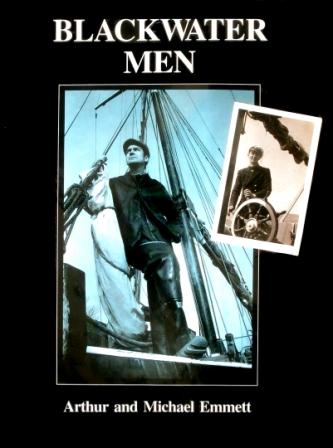 - Abundant Flounders were being
caught in the Blackwater in the early
1960s.
- Abundant Flounders were being
caught in the Blackwater in the early
1960s.
- They were stored in a “trunk” that were enclosed in redundant
submerged boats
- They were sold in Maldon
as Blackwater Plaice.
- One trip produced 210 stones of fish
- Herring spawned at Brightlingsea and Clacton were taken in large
quantities.
- Winkles from the Stumble
were main source of income for the Maldon fishermen.
- Over-fishing led to the downfall of the trade.
The
book also describes prolific eels and herrings being caught in the Blackwater
at that same time.
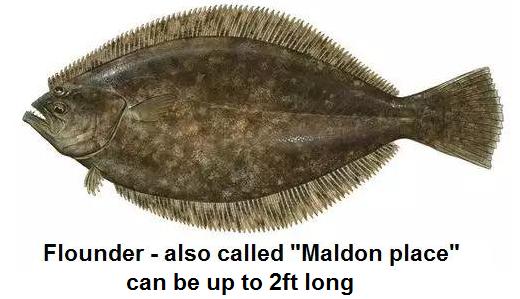
1967 The
Essex Naturalist: Marine Fauna of the Blackwater Estuary, by D.S. Davis.
This
60-page article gives a detailed insight into the population and condition of fish
stocks in the Blackwater Estuary in the 1960s. The study was undertaken to
determine possible biological effects of the Bradwell nuclear power station. The power station was in
operation from 1962 to 2002. The paper covers all types of fauna found in the
estuary including 41 species of “Pisces”. 11 are identified
as common/very common, 6 are listed as fairly/often common and 13 could be interpreted
as commercially fished.
Extracts
from the article are on a separate page on this site at... Marine Fauna of the Blackwater
Estuary - extracts
The complete paper can be
seen starting at... www.essexfieldclub.org.uk/portal/p/Archive/s/033/o/0002
The
fish section starts at... www.essexfieldclub.org.uk/portal/p/Archive/s/033/o/0055
1973 in September of this year two Goldhanger residents
fishing in the Blackwater with a seine net from a 16ft boat caught a total of
4cwt of sea bass in two trips, both
trips were at low tide and in still waters. The average weight of the fish was
recorded as 18lbs.
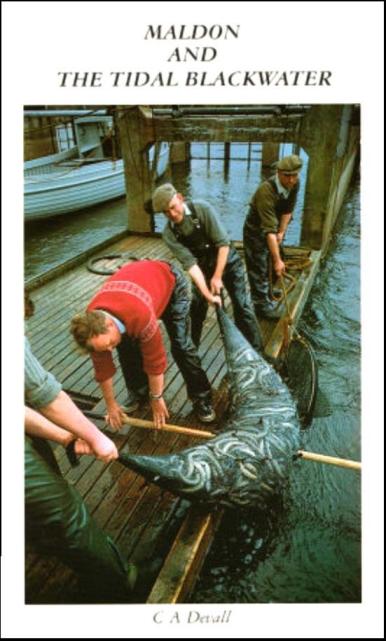 1998 from... Maldon and the Tidal
Blackwater, by C A Devall....
1998 from... Maldon and the Tidal
Blackwater, by C A Devall....
The former Maldon Corporation were responsible for the fishing rights in
the River Blackwater estuary, down to Stansgate creek. The river provided a
good living for many, as it was well stocked with oysters, mussels and winkles,
as well as eels, plaice
and the seasonal cod and haddock
etc. Even sturgeon were caught and
presented to the Monarch of the day. There were well established fishing communities
in Maldon and Heybridge, who earned a living from the trade.
The late Clarrie
Devall was founder of The Maldon Oyster
Company, which was established in 1960 and has large Oyster beds close to
Goldhanger Creek. The cover of his
book shows him pulling in an eel catch...
1999 Maldon and Burnham Standard...
Two fishermen downriver aboard the Danzel at the weekend enjoyed a
frantic Thornback session. The pair
managed no fewer than 16 quality specimens, ranging from 6lb to 18lb. Fresh
mackerel and squid was used on small hooks to great effect. They also had six
smoothounds which were returned to the river. With the bigger tides arriving
last weekend most boats stayed closer to home, finding more bass and roker with
traditional ragworm and crab baits. The midweek fishing has been very good out
from Bradwell, with the first of this year's bigger tope now being brought to
deck. Two men fishing on the boat Kingfisher caught 10 smoothounds
to 16.5lb and also had a brace of 40lb tope. Their boat also saw a terrific
52lb specimen taken.
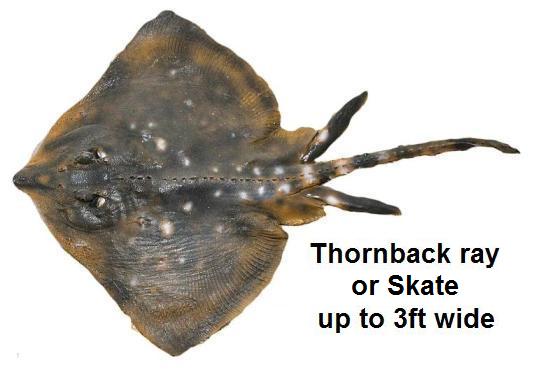
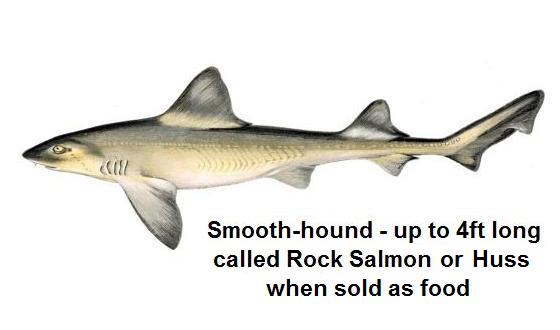
2000 In the “Tollesbury to the year 2000” Millennium book (Essex Library ref:
E.TOL.1), there is a 12 page chapter on The
Development of Fishing. It gives a very good insight into fish stocks and
the state of commercial fishing in the Blackwater Estuary leading up to the
Millennium. The chapter includes a list of 112 Tollesbury
fishing smacks that were registered in 1912.
Here are a few
short extracts...
In the 1960s and 70s there was a good stock of fish with plenty of John Dorys coming up the river in
summer. Such numbers of fish do not appear today. As fishing boats got bigger
and more powerful they could tow three nets instead of one. Ground lines have
got heavier, crushing all the food the fish are searching for; such fish as do
survive are tracked down with the assistance of electronic fish-finding
apparatus. In the latter part of the 20th century, Tollesbury has seen a drift
away from full-time fishing. A better living could be made elsewhere, however,
since fishing gets into the blood, many still felt compelled to continue
part-time or for sport.
At the turn of the millennium there is only one commercially registered
fishing boat based in Tollesbury. Probably the biggest factor in the demise of
full-time fishing was the European Union Fisheries Policy which came into play
in the early 1990s. EU members agreed to reduce the numbers of vessels fishing,
to conserve depleted fish stocks, and severe legislation affected quotas,
engine power, overall length, safety rules and equipment. It became illegal to
sell any fish unless caught by fully accredited and licenced fishing vessels.
Mesh sizes were strictly controlled (with severe penalties) for each type of
fish species and it now costs many thousands of pounds to comply with the
rules, in addition to the cost of a boat. As a result, local trawlers restrict
their fishing to pleasure and for personal consumption only.
Although interest in full-time fishing has declined, the numbers of fish
in the river can be said to have slowly recovered
for most species. Weather is vital to fish movements, and a series
of mild winters in the early 1990s enabled successful spawning to take place,
especially of cod. 1997/8 produced the best cod fishing in the area for 15
years. Fishing regulations imposed in 1979/80 also resulted in a revival of the
Blackwater herring. The 1998/9 sprat season was the best for many years and in
1991 Colchester had the largest landing of sprat in the UK, all caught in the
Blackwater.
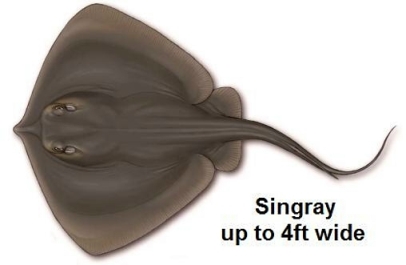
Cod and stingray come in healthy numbers and sizes and a ray of just under 90lb was
caught in the nets in 1996 on Shingle Hills (and released in good condition).
Large shoals of mullet appear in June. Bass have
increased over the last two years, the largest so far reeled-in in Tollesbury
waters weighed 5 lb. Through to Autumn there is only small scale fishing for
dabs, sole, plaice, flounders, bass, grey mullet, roker, cod and whiting.
Whiting stocks increase through September and October followed by codling and
cod. Then the herring return and "300
stone-a-hit" can be achieved by larger boats.
Mid-winter drift fishing for herring continues
in time-honoured tradition, as does spratting.
Roker, or thornback ray (skate) are
plentiful and many travel up river beyond Osea Island to spawn in the warming
water of Spring. 300 or more have been caught in a single haul. Dover sole still appear in mid-April as do
edible crabs and lobsters. Eels appear in May but their numbers have declined
drastically in recent years.
postcard views of
the Tollesbury fishing smacks
laid up in 1917 (approx.40 boats) in the Estuary in the
1930s at
Woodrope quay .
2001 Maldon and Burnham Standard...
It's official - porpoises do
exist in the Blackwater Estuary.
a photograph obtained exclusively by the Evening Gazette there is
concrete evidence that the rare harbour porpoise
is alive and well off the Essex coast. Maylandsea fisherman caught the creature
in his net off the Dengie peninsula near Burnham. The harbour porpoise is the
smallest cetacean in the world and is part of the whale family. The porpoise
was returned to the water.
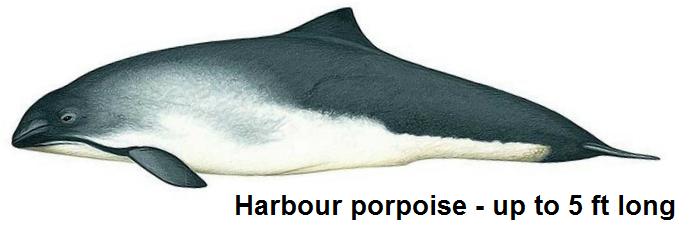
2001 - 2006 Marine Fish Nursery Function in the
Blackwater & Colne Estuary...
A short extract from this 5-page report
article is given here...
The full article is available at... www.kentandessex-ifca.gov.uk/.../Appendix-1-to-Agenda-item-B4.pdf
Migratory species including salmon,
sea trout
and eel are common to these
estuaries... Between 2001-2006 in the Blackwater & Colne estuary system
five sites were looked at... Sand-smelt
and bass nurseries existed at
both sites... Saltmarshes provides the optimum nursery ground for the very
early life stages of species such as bass...
The sprat nursery at Bradwell
appeared to be present for most of the year... Juvenile
sprats were also captured at Osea Island... A large catch of
2000+ juvenile
herring was taken in the managed realignment at Abbotts Hall in September
2003.
2002 Maldon and Burnham Standard...
A Southend angler landed a 12lb thornback ray
on a squid and hermit crab cocktail. A Benfleet fisherman landed the “Most
Species” trophy with his bag of tope, thornback, LSD and smoothound.
2003 Maldon and Burnham Standard...
Angling: Girls led the way as the Blackwater Challenge enjoyed tropical
conditions. The flotilla enjoyed a record-breaking festival with more than 200
fish landed over two days. A Thorpe Bay girl led the way bringing in a
top-class haul of four species to double the existing points record with her 26
fish. That earned her the day's top prize of the shield for best angler.
Friday's event was a haul of ray, smoothound
and tope to claim the Silver Claretin. A first-timer had a stunning
catch which included in 9lb ray taken on fresh mackerel to win the best lady
angler award.
2004 Management options for the Blackwater Herring, by The Centre for
Environment, Fisheries and Aquaculture Science (CEFAS) Laboratory, Lowestoft - a few short extracts from this 30-page
article published in 2004 are given
below...
The full article is available
at... https://academic.oup.com/icesjms/article/61/3/297/670918
Blackwater Herring or Blackwater stock, was first
recognized separately from the North Sea herring
stock in the early 1800s. The mature fish were small compared with
North Sea herring and catches could not compete in local markets. Only when the
general East Anglian herring fisheries began to collapse in 1955 and there was
a shortage of North Sea herring could Blackwater herring be sold without
difficulty.
By 1968 some 22 trawlers and driftnet vessels were targeting the stock
and catches peaked at 606 tons in the 1972–1973 season. A series of poor years
followed and as the stock declined restrictions were implemented, but stocks
continued to decline, and fishing was closed 1979.
Fishing was reopened in winter 1980 after a research survey identified
clear signs of stock recovery. At the start of the 1988–1989 fishing season, a
redefined area for a licensed, driftnet-only herring fishery was introduced in
the Thames Estuary. Herring caught inside this area were considered to belong
to the Blackwater spring-spawning stock, and landings were monitored so as not
to exceed the allowable Catch.
2006 Maldon and Burnham
Standard...
Dolphins are making a comeback in waters around Essex. There were six dolphins
and 81 harbour porpoises spotted around the county's coastline last year,
according to the Essex Harbour Porpoise Survey run by the Essex Biodiversity
Project. A white beaked dolphin and a bottlenose dolphin were among the mammals
reported by members of the public.
2014 Maldon and
Burnham Standard...
Essex police officers have been involved in one of their most unusual
wildlife operations – to prevent as many as 40 whales from being stranded on
beaches or sandbanks. Officers from the marine unit and the helicopter were
called in after the pod of pilot
whales was seen entering the River Blackwater. Members of British
Divers Marine Life Rescue called police and Coastguard when the whales were
close to shallow water at St Lawrence Bay. The whales were about five metres
long and in very shallow water with the tide receding.
2014 Maldon and Burnham Standard...
A whale belonging to a pod of 40 trapped off the Essex coast has died.
Despite best efforts by Essex Police and volunteers from the British Divers'
Marine Life Rescue, a six-foot female
pilot whale was recovered at Goldhanger this afternoon.
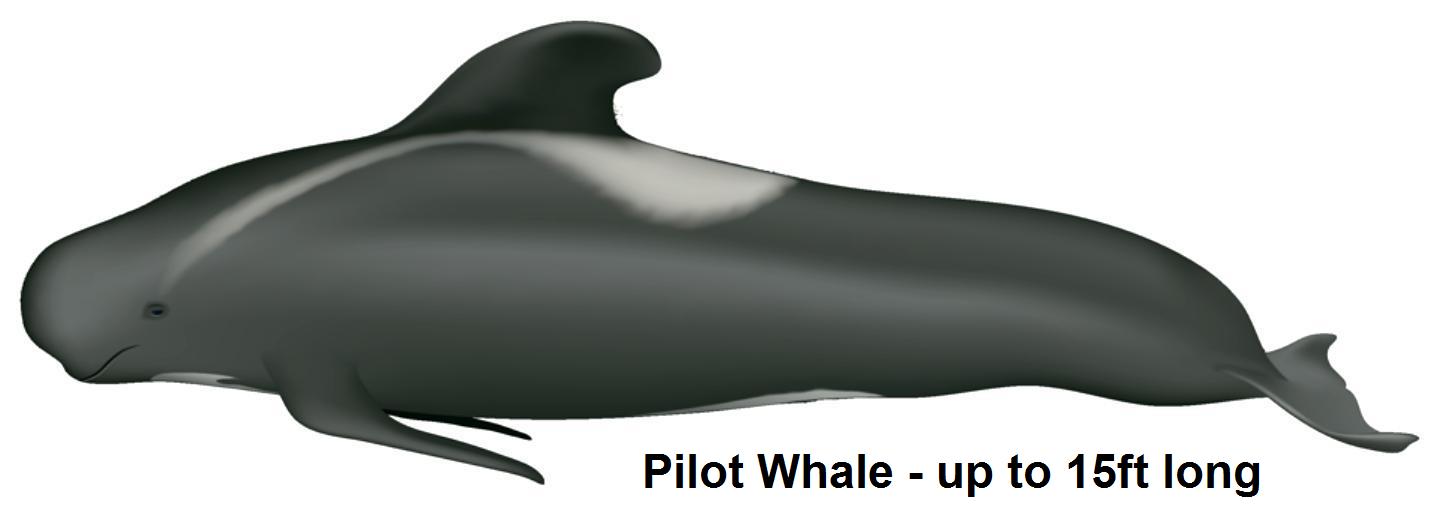
2014 The Guardian...
Stranded long-finned Pilot Whale
on an Essex river
A female calf found on the beach near Goldhanger died in very poor
nutritional condition. The 2-metre female was one of a pod of up to 40 that
frequent coastal shallows near the Blackwater estuary and was seen feeding on
herring earlier this week.
2015-6 Maldon & Burnham Standard...
Several reports of Harbour Porpoises
seen in the Blackwater Estuary, both dead and alive.
2016 Maldon &
Burnham Standard...
May - Famous seal known to visit
River Blackwater and the Mersea Jetty spotted again
The harbour seal, nicknamed Sammy, has been seen many times along the
river and jetty, and was seen again in the Blackwater near Fullbridge. The
coasts of Maldon District are known for accommodating many grey seals as well
as the common harbour breeds, and although they will come further inland to
feed, they breed further out to sea. Sammy appears on the Jetty and along the
river because he is attracted to the scraps of bacon used by those crab fishing
along the shore.
2018 The Maylands
Mayl Magazine...
April - The Blackwater is home to
a wide diversity of marine species, including Grey and Harbour Seals
For many decades our foreshores have been graced by their presence, but
there has been little documented over recent years to understand their current
numbers and behaviour. The Marine Education and Research Institute will be
working alongside Maldon District Council and the Zoological Society of London
to change that.
We have been spending time surveying the River Blackwater recording
their behaviour, abundance and distribution.The seals move around the River
dependent on the tides. At high tide, in numbers of up to 15, they head out of
the Blackwater to feed. When the tide starts to drop, they return to their haul
out sights, rest and interact with each other.
2019 Chelmsford
Weekly News
August – a dead dolphin washes up
in Blackwater Estuary near Goldhanger
It was an adult female about 6 feet 6 inches long...
2019 Braintree Sea Angling Club Newsletter
In September a Braintree Sea Angling Club member fishing out of West
Mersea onboard the Enterprise made a rare catch of a 23 ½lb stingray...
2019 Maldon & Burnham Standard...
December - a quarter-tonne
leatherback turtle was discovered stranded in Mundon Creek on the Blackwater
Sightings of leatherback turtles in British waters are not unknown - but
finding one on the east coast is rare, according to the Cetacean Stranded
Investigation Programme (CSIP). They are more usually seen in the warmer,
deeper waters closer to their natural habitat of the Atlantic Ocean. In 2019
twelve sightings of leatherback turtles were reported in British and Irish
waters, with only three washed up on beaches. They mainly feed on jellyfish.
2020 Gazette & Essex County Standard...
August - a ten-year-old fishing
enthusiast made a “once-in-a-lifetime” catch
He snagged a hulking stingray in the waters off Mersea which would have
weighed between 40 and 50lbs. The father and son duo got the stingray as close
to their boat as they could before the line broke and the ray swam away...
2023 Maldon Standard and Nub News...
Large fish and aquatic mammals continue to
appear occasionally in the Blackwater and are reported in the local press.
It is an indication that conservation
schemes put in place over the years have been effective
Fishing in the Blackwater recently
Commercial
and sport fishing in the Blackwater estuary is today regulated, and since 2013
the estuary has been Marine Conservation
Zone, which is described at...
Natural
England’s Conservation Advice and maps for the Blackwater Marine Protected Area
is at...
advice
on fishing and other activities in the Blackwater Estuary can be obtained from
Maldon Council’s River Bailiff at...
fishing
on parts of the Blackwater is also regulated by the Kent & Essex Inshore Fisheries and Conservation Authority at...
the
Fishing Regulations Blue Book is a
single collection of all UK and EU laws and is can be found at...
www.gov.uk/government/publications/fishing-regulations-the-blue-book
Today
there is no commercial fishing at Goldhanger and fresh fish businesses have only
been identified at Maldon and Mersea Island. Suggest searching for: Maldon fresh fish and Mersea Island fresh fish.
(however even online links
tend to get outdated, see... Those magnificent links)
A summary
Although
much tangible local evidence exists, in the form of fish traps, a jetty, fish
pits and a saltworks, as described in the above Commercial
fishing legacies section, Local documentary evidence
shows that few records have been found to support the existence of an
“extensive fishing trade” based at Goldhanger village when compared with
the commercial trade recorded elsewhere on the Blackwater, such as in Maldon,
Mersea and Tollesbury.
One
reason for the lack of recorded evidence of a fishing trade at Goldhanger or
indeed elsewhere is that no ownership of land or property was involved. Nor was
it practical in the past to collect taxes from the product of commercial
fishing. So few legal or statutory documents such as Deeds, customs records or
government surveys were produced that refer to either commercial or
non-commercial fishing here or elsewhere.
In
contrast, records of fish stocks and unusual species goings going back hundreds
of years produced by naturalists, antiquarians and game fishermen and presented
in the Records of fishing and exceptional fish above,
show that the Blackwater Estuary has always been a rich and diverse source of
fish and seafood. There is also more than enough evidence to confirm that in
the past Goldhanger residents enjoyed the benefits of this local natural
resource both for commercial and personal use.
The
legacy of paintings and drawings of fishing
smacks at sea going back centuries gives an indication of the hazards and
scale of this commercial trade.
Although
it is difficult to interpret fishing trends from records, a comparison between
the data from Dr. Laver’s 1898
paper and D.S.Davis’s 1967
paper shows that fish stocks did not significantly change between those
years. There is no evidence that the Bradwell nuclear reactor ever resulted in
any pollution that affected fish stocks, on the contrary it has be suggested in
the past that the large quantities of warm water pumped into the estuary at both
Bradwell and Sizewell actually encouraged fish development!
Large
scale industrial activities in the upper reaches of the Blackwater and Chelmer
rivers in the first half of the 20th century resulted in significant pollution
of the estuary with heavy metals such as lead and mercury. It is also known
that surplus explosives and chemicals were dumped in the estuary at the end of
WW-2. This together with over-fishing in
the North Sea may well have resulted in a decline in fish stocks in the estuary
in that period. However in the last 50 years European Union fishing regulations
and UK river water quality controls has resulted a recovery of fish stocks,
albeit at the cost of controlling and limiting commercial
fishing.
Finally,
one can now speculate why commercial fishing progressively disappeared from
Goldhanger...
o When larger boats became available at other
locations around the estuary that could move further out into the North Sea,
there was insufficient depth of water to accommodate these bigger boats in the
creek and using the smaller boats became uncompetitive.
o Many
of the species that were (and until quite recently still are) fished
commercially only appear in the upper reaches of estuary at certain times of
the year, which probably made a commercial operation that was limited to a
local area uneconomic.
o The
ancient wooden jetty would have needed constant repairs
and replacement timbers, and this may have become been impractical in the
circumstances.
o The
proliferation of the remnants of fish traps on the north
bank of the estuary, that at certain depths of water lie just under the
surface, would always have made fishing from small boats on the north bank a
dangerous operation.
o Local fishing and salt
making could well have been inextricably linked to smuggling
activities in the village, and when the coastguards
arrived in the 1820s and erected their hut on the seawall next to the fish pits and the saltworks, and overlooking the jetty, the
“game was up” and both activities were forced to cease.
o The arrival of railways
revolutionised the movement of fresh fish inland, and the lack of a railway at Goldhanger would have made it
uncompetitive compared with Maldon and Tollesbury.
o Both the Coastguard
Service and the Royal Navy actively recruited personnel with seafaring
experience particularly during WW-1. Young local
fishermen would have found this an attractive career with a reliable and steady
income.
DWN updated in 2025
top &
contents list Estuary
activities home
